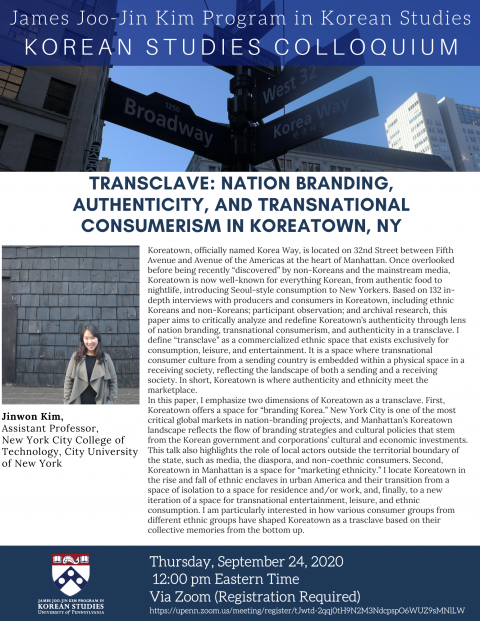
Korean Studies Colloquium
Via Zoom
*Registration required: please register via the following link: https://upenn.zoom.us/meeting/register/tJwtd-2qqj0tH9N2M3NdcpspO6WUZ9sMNlLW
Koreatown, officially named Korea Way, is located on 32nd Street between Fifth Avenue and Avenue of the Americas at the heart of Manhattan. Once overlooked before being recently “discovered” by non-Koreans and the mainstream media, Koreatown is now well-known for everything Korean, from authentic food to nightlife, introducing Seoul-style consumption to New Yorkers. Based on 132 in-depth interviews with producers and consumers in Koreatown, including ethnic Koreans and non-Koreans; participant observation; and archival research, this paper aims to critically analyze and redefine Koreatown’s authenticity through lens of nation branding, transnational consumerism, and authenticity in a transclave. I define “transclave” as a commercialized ethnic space that exists exclusively for consumption, leisure, and entertainment. It is a space where transnational consumer culture from a sending country is embedded within a physical space in a receiving society, reflecting the landscape of both a sending and a receiving society. In short, Koreatown is where authenticity and ethnicity meet the marketplace.
In this paper, I emphasize two dimensions of Koreatown as a transclave. First, Koreatown offers a space for “branding Korea.” New York City is one of the most critical global markets in nation-branding projects, and Manhattan’s Koreatown landscape reflects the flow of branding strategies and cultural policies that stem from the Korean government and corporations’ cultural and economic investments. This talk also highlights the role of local actors outside the territorial boundary of the state, such as media, the diaspora, and non-coethnic consumers. Second, Koreatown in Manhattan is a space for “marketing ethnicity.” I locate Koreatown in the rise and fall of ethnic enclaves in urban America and their transition from a space of isolation to a space for residence and/or work, and, finally, to a new iteration of a space for transnational entertainment, leisure, and ethnic consumption. I am particularly interested in how various consumer groups from different ethnic groups have shaped Koreatown as a trasclave based on their collective memories from the bottom up.
 James Joo-Jin Kim Center for Korean Studies
James Joo-Jin Kim Center for Korean Studies